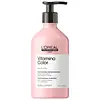What's inside
What's inside
 Key Ingredients
Key Ingredients

 Benefits
Benefits

 Concerns
Concerns

 Ingredients Side-by-side
Ingredients Side-by-side

Water
Skin ConditioningSodium Laureth Sulfate
CleansingCocamidopropyl Betaine
CleansingDimethicone
EmollientSodium Chloride
MaskingCitric Acid
BufferingHexylene Glycol
EmulsifyingSodium Benzoate
MaskingSodium Hydroxide
BufferingAmodimethicone
Carbomer
Emulsion StabilisingGuar Hydroxypropyltrimonium Chloride
Skin ConditioningTrideceth-10
CleansingGlycerin
HumectantSalicylic Acid
MaskingGlycol Distearate
EmollientLinalool
PerfumingMica
Cosmetic ColorantPEG-100 Stearate
Hexyl Cinnamal
PerfumingPhenoxyethanol
PreservativeSteareth-6
EmulsifyingCoco-Betaine
CleansingTrideceth-3
EmulsifyingCI 77891
Cosmetic ColorantLimonene
PerfumingChenopodium Quinoa Seed Extract
Skin ConditioningAcetic Acid
BufferingFumaric Acid
BufferingHydrolyzed Wheat Protein
Skin ConditioningCI 19140
Cosmetic ColorantHydrolyzed Corn Protein
Skin ConditioningHydrolyzed Soy Protein
HumectantCI 17200
Cosmetic ColorantParfum
MaskingWater, Sodium Laureth Sulfate, Cocamidopropyl Betaine, Dimethicone, Sodium Chloride, Citric Acid, Hexylene Glycol, Sodium Benzoate, Sodium Hydroxide, Amodimethicone, Carbomer, Guar Hydroxypropyltrimonium Chloride, Trideceth-10, Glycerin, Salicylic Acid, Glycol Distearate, Linalool, Mica, PEG-100 Stearate, Hexyl Cinnamal, Phenoxyethanol, Steareth-6, Coco-Betaine, Trideceth-3, CI 77891, Limonene, Chenopodium Quinoa Seed Extract, Acetic Acid, Fumaric Acid, Hydrolyzed Wheat Protein, CI 19140, Hydrolyzed Corn Protein, Hydrolyzed Soy Protein, CI 17200, Parfum
Ingredients Explained
These ingredients are found in both products.
Ingredients higher up in an ingredient list are typically present in a larger amount.
This water-soluble silicone is used for its hydrating and softening properties. It is used to add a silky feel to skincare products and has great benefits for haircare.
In haircare, this ingredient:
- Adds shine
- Protects color
- Offers thermal protection
- Boosts hair strength
- Does not build up as easily
Citric Acid is an alpha hydroxy acid (AHA) naturally found in citrus fruits like oranges, lemons, and limes.
Like other AHAs, citric acid can exfoliate skin by breaking down the bonds that hold dead skin cells together. This helps reveal smoother and brighter skin underneath.
However, this exfoliating effect only happens at high concentrations (20%) which can be hard to find in cosmetic products.
Due to this, citric acid is usually included in small amounts as a pH adjuster. This helps keep products slightly more acidic and compatible with skin's natural pH.
In skincare formulas, citric acid can:
While it can provide some skin benefits, research shows lactic acid and glycolic acid are generally more effective and less irritating exfoliants.
Most citric acid used in skincare today is made by fermenting sugars (usually from molasses). This synthetic version is identical to the natural citrus form but easier to stabilize and use in formulations.
Read more about some other popular AHA's here:
Learn more about Citric AcidLinalool is a fragrance and helps add scent to products. It's derived from common plants such as cinnamon, mint, citrus, and lavender.
Like Limonene, this ingredient oxidizes when exposed to air. Oxidized linalool can cause allergies and skin sensitivity.
This ingredient has a scent that is floral, spicy tropical, and citrus-like.
Learn more about LinaloolParfum is a catch-all term for an ingredient or more that is used to give a scent to products.
Also called "fragrance", this ingredient can be a blend of hundreds of chemicals or plant oils. This means every product with "fragrance" or "parfum" in the ingredients list is a different mixture.
For instance, Habanolide is a proprietary trade name for a specific aroma chemical. When used as a fragrance ingredient in cosmetics, most aroma chemicals fall under the broad labeling category of “FRAGRANCE” or “PARFUM” according to EU and US regulations.
The term 'parfum' or 'fragrance' is not regulated in many countries. In many cases, it is up to the brand to define this term.
For instance, many brands choose to label themselves as "fragrance-free" because they are not using synthetic fragrances. However, their products may still contain ingredients such as essential oils that are considered a fragrance by INCI standards.
One example is Calendula flower extract. Calendula is an essential oil that still imparts a scent or 'fragrance'.
Depending on the blend, the ingredients in the mixture can cause allergies and sensitivities on the skin. Some ingredients that are known EU allergens include linalool and citronellol.
Parfum can also be used to mask or cover an unpleasant scent.
The bottom line is: not all fragrances/parfum/ingredients are created equally. If you are worried about fragrances, we recommend taking a closer look at an ingredient. And of course, we always recommend speaking with a professional.
Learn more about ParfumWater. It's the most common cosmetic ingredient of all. You'll usually see it at the top of ingredient lists, meaning that it makes up the largest part of the product.
So why is it so popular? Water most often acts as a solvent - this means that it helps dissolve other ingredients into the formulation.
You'll also recognize water as that liquid we all need to stay alive. If you see this, drink a glass of water. Stay hydrated!
Learn more about Water